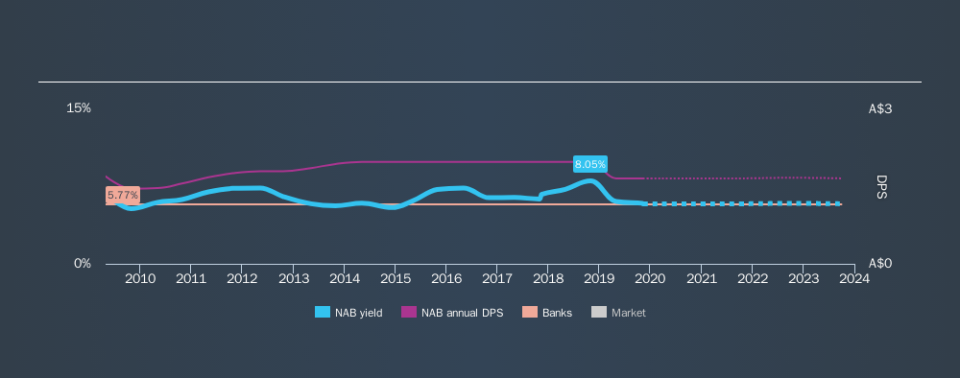Dividend Investors: Don't Be Too Quick To Buy National Australia Bank Limited (ASX:NAB) For Its Upcoming Dividend

It looks like National Australia Bank Limited (ASX:NAB) is about to go ex-dividend in the next 4 days. Investors can purchase shares before the 14th of November in order to be eligible for this dividend, which will be paid on the 12th of December.
National Australia Bank's next dividend payment will be AU$0.8 per share, on the back of last year when the company paid a total of AU$1.7 to shareholders. Looking at the last 12 months of distributions, National Australia Bank has a trailing yield of approximately 5.8% on its current stock price of A$28.47. We love seeing companies pay a dividend, but it's also important to be sure that laying the golden eggs isn't going to kill our golden goose! So we need to investigate whether National Australia Bank can afford its dividend, and if the dividend could grow.
See our latest analysis for National Australia Bank
Dividends are typically paid from company earnings. If a company pays more in dividends than it earned in profit, then the dividend could be unsustainable. Last year National Australia Bank paid out 93% of its profits as dividends to shareholders, suggesting the dividend is not well covered by earnings.
When the dividend payout ratio is high, as it is in this case, the dividend is usually at greater risk of being cut in the future.
Click here to see the company's payout ratio, plus analyst estimates of its future dividends.
Have Earnings And Dividends Been Growing?
Businesses with shrinking earnings are tricky from a dividend perspective. If earnings decline and the company is forced to cut its dividend, investors could watch the value of their investment go up in smoke. So we're not too excited that National Australia Bank's earnings are down 3.5% a year over the past five years.
The main way most investors will assess a company's dividend prospects is by checking the historical rate of dividend growth. National Australia Bank's dividend payments are effectively flat on where they were ten years ago. If a company's dividend stays flat while earnings are in decline, this is typically a sign that it is paying out a larger percentage of its earnings. This can become unsustainable if earnings fall far enough.
To Sum It Up
Is National Australia Bank an attractive dividend stock, or better left on the shelf? Earnings per share are in decline and National Australia Bank is paying out what we feel is an uncomfortably high percentage of its profit as dividends. It's not that we hate the business, but we feel that these characeristics are not desirable for investors seeking a reliable dividend stock to own for the long term. National Australia Bank doesn't appear to have a lot going for it, and we're not inclined to take a risk on owning it for the dividend.
Ever wonder what the future holds for National Australia Bank? See what the 12 analysts we track are forecasting, with this visualisation of its historical and future estimated earnings and cash flow
If you're in the market for dividend stocks, we recommend checking our list of top dividend stocks with a greater than 2% yield and an upcoming dividend.
We aim to bring you long-term focused research analysis driven by fundamental data. Note that our analysis may not factor in the latest price-sensitive company announcements or qualitative material.
If you spot an error that warrants correction, please contact the editor at editorial-team@simplywallst.com. This article by Simply Wall St is general in nature. It does not constitute a recommendation to buy or sell any stock, and does not take account of your objectives, or your financial situation. Simply Wall St has no position in the stocks mentioned. Thank you for reading.

 Yahoo Finance
Yahoo Finance 
